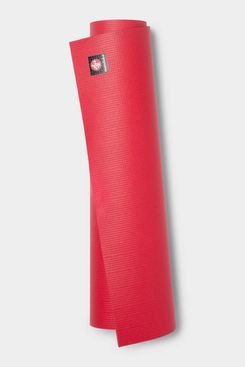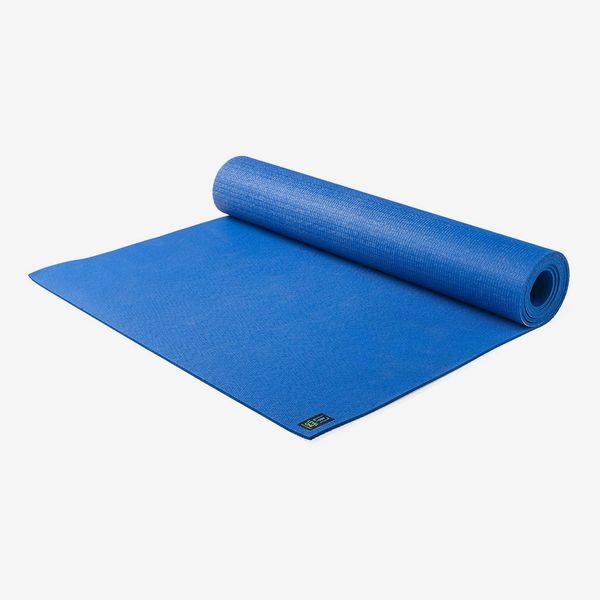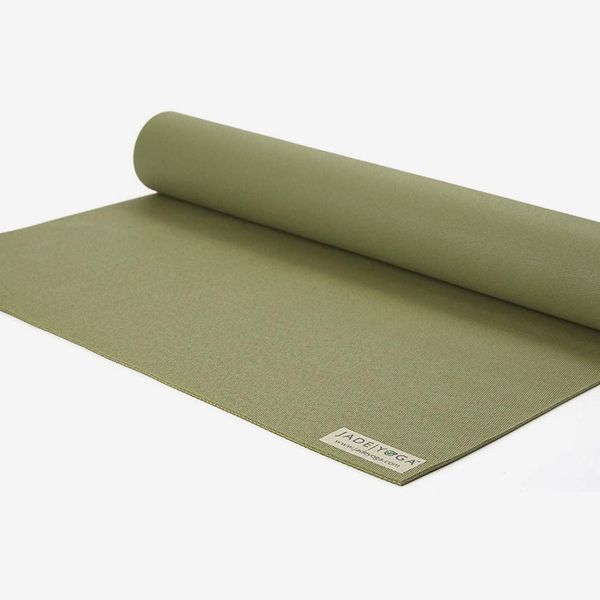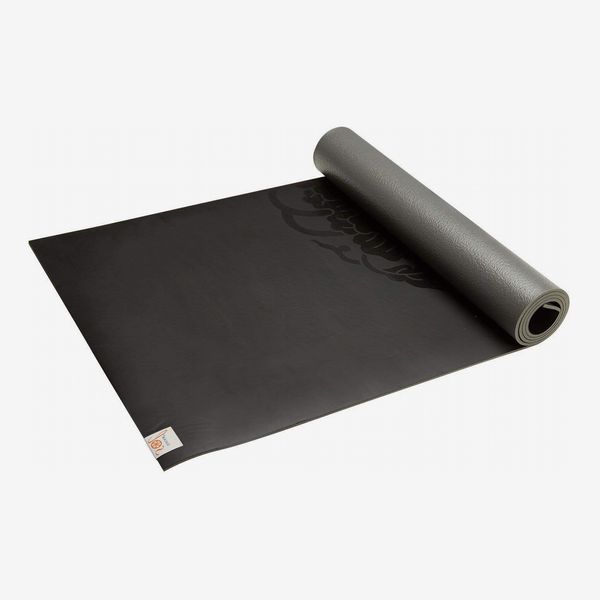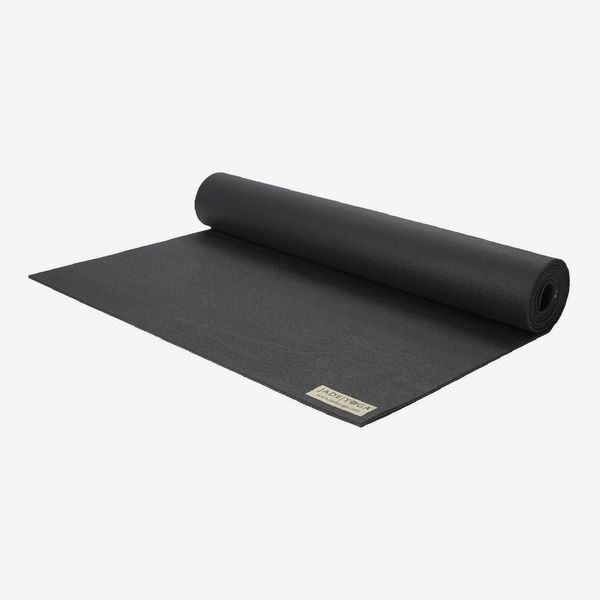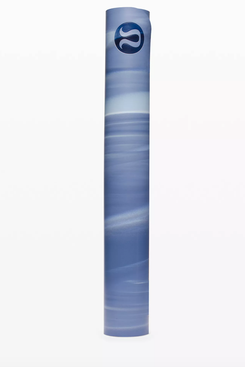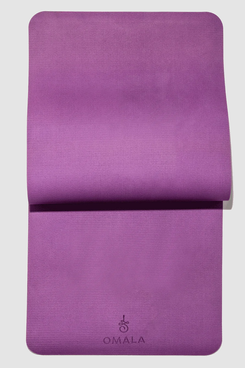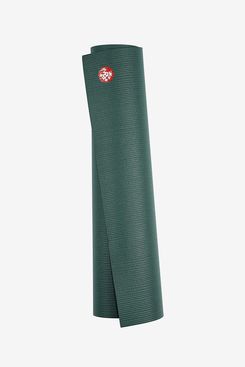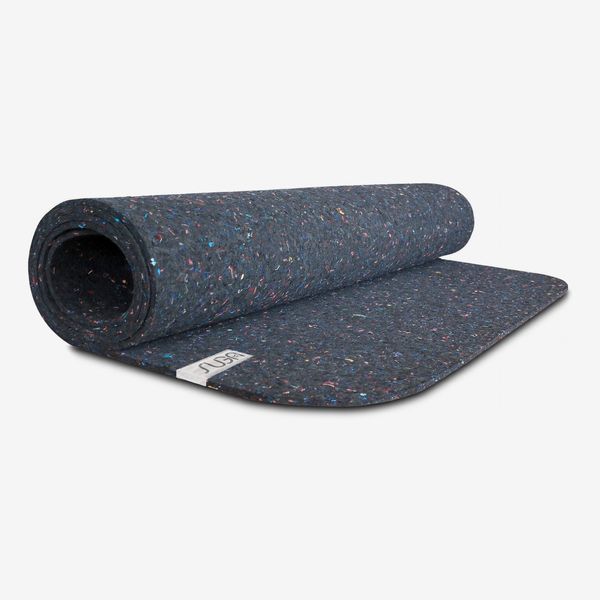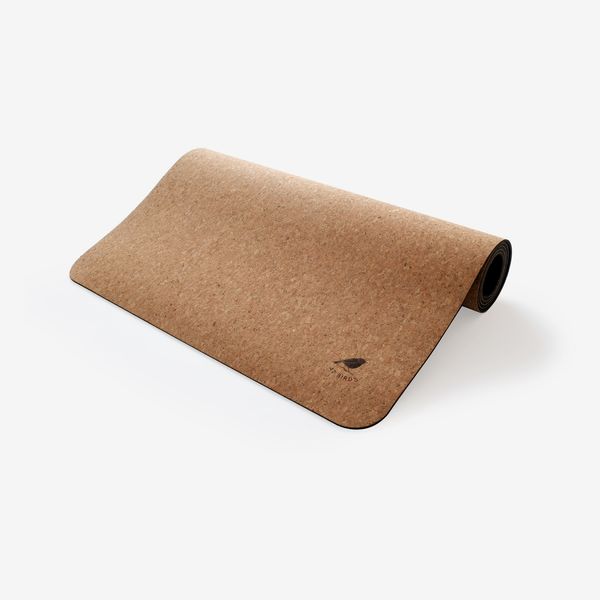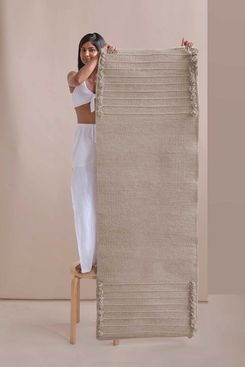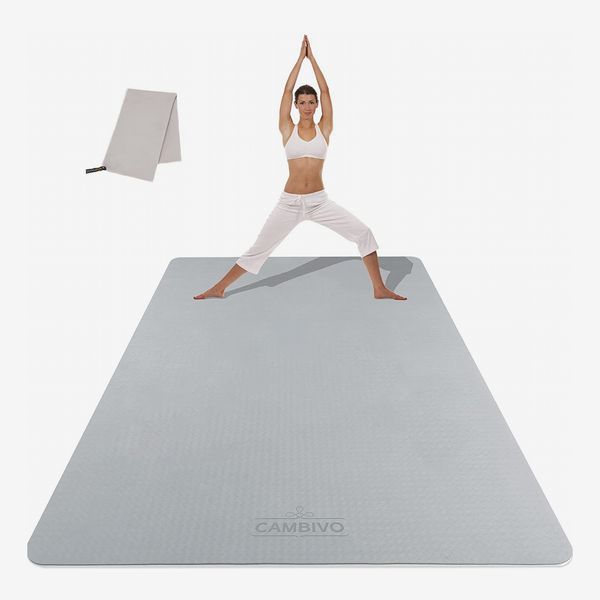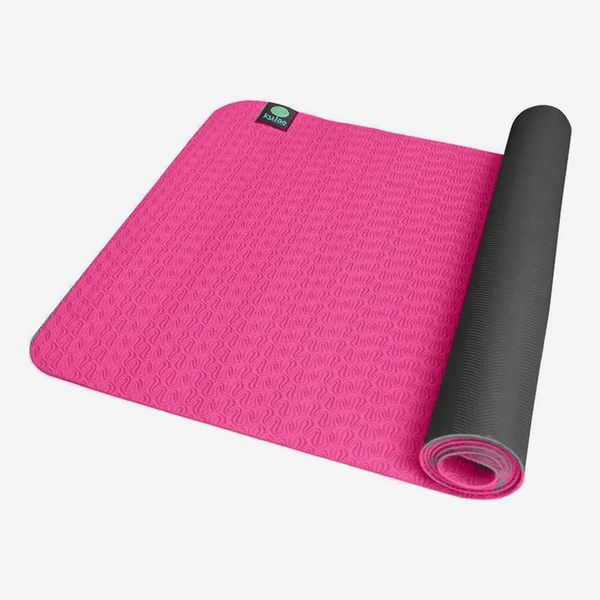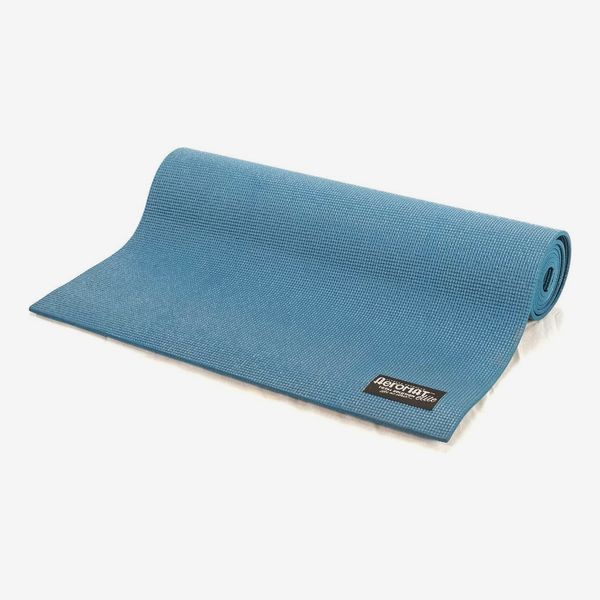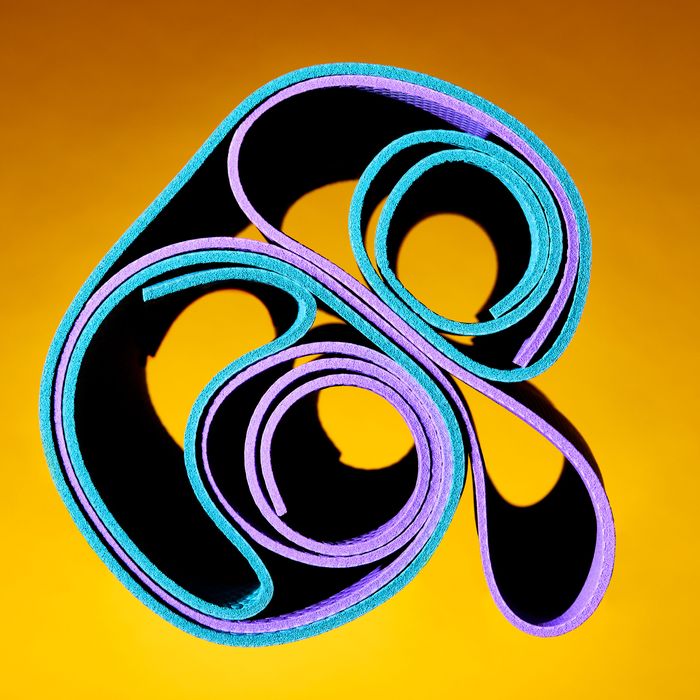
In this article
Whether you’re a regular at your local yoga studio or have gotten into the habit of doing your downward dogs with a virtual class, you’ll need a reliable mat on hand. For the past seven years, I’ve been using a yoga mat for all of my at-home workouts, including body-weight exercises, light kettlebell workouts (though I recommend dedicated gym mats for heavier weight lifting sessions), and stretching or rolling out on a foam roller. But not all yoga mats are the same. Too slippery, and your downward dogs will feel hazardous; too grippy, and you might find your mat coming with you when you jump forward during sun salutations.
To help you find the Goldilocksian ideal of yoga mats — along with some specific options for those in search of, say, a cushiony mat that’s especially supportive to joints or one that’s especially lightweight — I tested many options during at-home yoga sessions or doing bodyweight exercise, including models from Manduka, Jade, Gaiam, and Lululemon, the best-known brands in the space. I also reached out to yogis, studio owners, and fitness experts to hear about their favorites. Check out our table of contents above to jump right to the type of mat you’re looking for, or read on to learn more about how to pick the best one for you.
What we’re looking for
Dimensions
Most yoga mats are 24 inches wide and between 68 and 72 inches long. If you get a mat in this range it should fit neatly in the rows in your studio. If you’re tall, it might be worth looking for a mat on the higher end of this range, or even above it, to make sure you have enough space. Wider mats give you a little more room from side to side, but just be aware that some yoga studios discourage these mats because they can alter the number of people who can fit in each row of the classroom. A few mats on our list come in different sizes, which we’ve indicated for each one below. (All measurements below are listed in the order of length by width.)
Thickness
Yoga mats range from pancake thin to extra thick and cushy. Thinner mats give you more ground contact, which some yogis like feeling underneath their feet (especially in standing poses when you want a firm foundation). Thicker ones tend to feel more plush and supportive. If you have any sensitivities in your joints or your back, you may prefer the softness of a thicker mat.
Weight
The weight of your mat might not matter much if you’re practicing at home, but if you’re lugging it back and forth from the yoga studio in your bag or on your back, you’ll feel the difference a few ounces make. Thicker mats tend to weigh more, so keep that in mind when balancing your needs for cushioning versus portability.
Material
Most yoga mats are made from either rubber, cork, or polyvinyl chloride (PVC), a synthetic plastic polymer. (It’s less common, but some yoga mats are made from fabrics like cotton.) Rubber mats are more sustainable as they’re made from naturally sourced and biodegradable material, but they may be irritating if you’re allergic to latex (latex proteins are found in rubber). PVC tends to be lighter and less expensive. Rubber is grippier, while PVC is smoother and can feel more slippery. Cork mats are sustainable, too, because they’re made from tree bark that is harvested without deforestation. Cork mat surfaces are smooth and soft to the touch, and since cork is hydrophobic, it doesn’t get slippery when wet. They also are easy to clean since cork is naturally antimicrobial.
Best yoga mat overall
Dimensions: Standard: 71” x 24”, Long: 79” x 24” | Thickness: 4.7 mm | Weight: Standard: 4 lbs, Long: 4.5 lbs | Material: PVC
I’ve used the PROlite for both yoga sessions and at-home bodyweight exercises, and I like how its surface feels slightly tacky when dry, which helps with grip. When I started to sweat, I noticed that it lost its grip a little, but not so much that I slipped or became unstable. Three of the yogis we talked to named Manduka’s PROlite mat as their go-to for daily practice. “The Manduka mat is indulgent — it’s grippy, soft, and breaks in very well,” says yoga instructor Kyle Miller. And while the mat certainly isn’t the least expensive of the ones on this list, Miller told us it holds up well over time. Kristen Nichols, an instructor at Y7 Studio, agrees that Manduka is a quality brand and that its lightweight mats are durable. She also notes that the mat “can get slippery, but it’s meant to — it’s designed to make you engage more.” Alexandria Brzenk, a private yoga instructor, is a fan of Manduka’s PROlite mat as well and says she uses it both for home practice and for teaching at her studio. “I prefer the texture of this mat over rubber mats because it makes flowing through transitions smoother while also offering enough traction so that my hands don’t slip in down dog,” she says. According to Brzenk, the mat also offers comfortable, full-body support: “It provides cushioning for the joints without sacrificing stability in standing postures.” And if you’re carrying it to the studio, Nichols notes this one is easy to take on the go.
Best (less-expensive) overall yoga mat
Dimensions: 68” x 24” | Thickness: 4 mm | Weight: 4 lbs | Material: Rubber
If you’re not ready to drop nearly $100 on a yoga mat, I recommend Jade’s Level 1 mat, which is only about half the cost of our best overall pick. “It has the best traction for your hands and feet, so no slipping,” says Krissy Jones, a co-founder of New York’s Sky Ting yoga studio. All Jade mats are made from all-natural rubber so they’ll feel grippier than PVC alternatives. The mat is also lightweight and rolls up easily, making it particularly storable if you’re using it to practice at home (and ideal for carrying it to the studio). At four millimeters thick, it won’t feel as plush as our top choice, but it’s far from threadbare.
Best extra-grippy yoga mat
Length: Available in three: 68” x 24”, 71” x 24”, and 74” x 24” | Thickness: 4.7 mm | Weight: 4.5 lbs | Material: Rubber
If you’re looking for a mat that’ll make you feel a bit more secure (especially for those engaging in sweatier workouts), Jade’s Harmony yoga mat is a grippy, stable option that helps with planting your hands and feet during poses. I’ve used the Harmony since 2019 and like how the mat lies flat, unlike some lighter-weight PVC models I’ve tested. Its edges don’t curl up and get in the way of poses that use the ends of the mat. It’s also a favorite of the yoga instructors we talked to (as well as Pilates instructors and senior vice-president and publisher at Pantheon & Schocken Books Lisa Lucas) when it comes to grip. “They’re sticky, so your hands and feet don’t slide, and they’re durable, so you can put them in washing machines,” says Liz Wexler, a yoga instructor and former group-fitness manager at Equinox. Patrick Foley, a manager and teacher at Sky Ting, says that they “stock all of our studios with Jade mats” and that he uses one for his home practice as well. “The natural rubber is ecofriendly and provides great grip even when you get a little bit sweaty, and it’s thick enough to provide a little cushion,” he says. If the price seems somewhat high, Wexler assures us that it’s worth the investment: “They’ll also last for a really long time, several years.” Jade’s Harmony model is made from the same grippy natural rubber as its less-expensive Level 1 mat but is thicker for more plushness and comes in three different length options.
Best less-expensive extra-grippy yoga mat
Length: Available in two: 68” x 24” and 78” x 26” | Thickness: 5mm | Weight: 4.25 lbs | Material: PVC
If you’re looking to create a hot-yoga experience at home, you need a mat that can maintain its grip when you sweat it out. This 5-mm.-thick mat from Gaiam comes recommended by Bethany Lyons, the founder of Lyons Den Power Yoga. “I just love the feel and grip of this mat,” she says. Fashion designer Eileen Fisher, who’s done yoga for over 40 years and practiced daily for over 17 years, is also a big fan of this Gaiam mat. Fisher says its five-millimeter thickness offers just the right amount of cushioning and adds that it isn’t slippery. The grippy top coating that keeps its stickiness when damp, which helps your hands and feet stay grounded.
Best lightweight yoga mat
Length: Available in two: 68” x 24” and 74” x 24” | Thickness: 3 mm | Weight: 3.5 lbs | Material: Rubber
Jade Yoga’s travel mat is a versatile option if you plan on using just one mat for classes, for travel, and at home. It’s lightweight (at just over three pounds), easy to clean, and great for practicing both outdoors and indoors. Plus, it has the same nonstick textured rubber surface as the Jade Harmony mat above, so it’s also very grippy. Sharron Lynn, founder of the wellness community Breathe Flow Be, heard about the mat from a fellow yogi who thought it would give her better traction in practice. “I was taking a ton of hot-yoga classes and had issues with my hands slipping due to sweat and moisture from the heated room. She recommended Jade’s mats about three years ago, and I’ve been using them ever since.” This travel style is one of the thinnest mats on our list so it’s not the one to choose if you like a lot of support. It will give you the sensation of stability in standing poses, though, and its thinness keeps the weight very low, so it’s easy to tote around.
Best double-sided yoga mat
Length: 71” x 26” | Thickness: 3 mm | Weight: 3.87 lbs | Material: Rubber and polyurethane
If you’re torn between the feel of textured rubber and smooth synthetic, I recommend this reversible mat that’s basically two mats in one. One side is made from polyurethane (a plastic similar to PVC) while the other is lined with natural rubber for a softer, grippier feel. “I use the smooth side up during a Vinyasa flow, allowing easy transitions,” says yoga teacher Hannah Gardner, and then for hot yoga, “having the grip side up keeps me from sliding around.” At three millimeters it’s a very thin mat (and almost as lightweight as the Jade Travel model) so it won’t provide a ton of cushioning. Yoga instructor Tochi Anueyiagu says it feels “springy” and likes that the natural rubber surface is easy to clean. Outdoor-gear writer Joe Jackson likes the squishier five-millimeter version for doing body-weight exercises on his back deck (though he recommends even thicker mats for any workouts involving weights). At 26 inches wide, it gives you a hair more room to move side to side than a standard 24-inch mat.
Best yoga mat for form
Length: 70” x 24” | Thickness: 5 mm | Weight: 4.96 lbs | Material: PVC
If you’re looking for a little more help with your form, consider this plush mat from Omala, which changes color. Former senior editor Chelsea Peng has been using it for the past two months, and says “it’s truly such a helpful tool if you’re practicing yoga at home by yourself because the mat is a visual alignment guide.” The Omala changes color based on heat and pressure, so “you can leave foot and handprints and see how well they line up when you change poses,” she says. Peng doesn’t have a mirror in her yoga space, so she found the color-changing feature more helpful to her than just relying on feel. According to Peng, the Omala has a few slight downsides to look out for. The smell when you first unbox it is “quite strongly floral (not unpleasant, just a lot, but it doesn’t smell very much at all after you leave it out),” she says, and adds that you have to be careful with rolling and with storage because the coating that does the color-changing can scratch off.
Best cushioned yoga mat
Length: Standard: 71” x 26”, Extra Long: 85” x 26” | Thickness: 6 mm | Weight: Standard: 7.5 lbs, Extra Long: 9.5 lbs | Material: PVC
Our best overall yoga mat is actually the lighter version of this super-cushy mat. While the “lite” mat is a crowd pleaser with its middle-of-the-road thickness and commute-friendly weight, the PRO is for those seeking a truly plush feel. At six millimeters thick, it’s the most cushioned mat on our list, but at seven and a half to nine and a half pounds (depending on the length) it’s also the heaviest — so it’s maybe not the best pick if you’re carrying it from home, to work, to the studio, and back. Sarah Neufeld, co-founder of Modo Yoga, tells us that she always uses Manduka mats and that the PRO is her go-to for at-home practice. “When you get the PRO, at first it feels slippery, but then a couple of weeks into using it, it starts to get perfect,” she says. “Five to ten years later, it gets even better and stays grippy.” Neufeld notes that the Manduka PRO mat is “really heavy,” but that it gives “a lot of support.” Heather Lilleston and Katelin Sisson, the founders of Yoga for Bad People, agree: “For home practice, a bit more cushion and density are sometimes nice,” they told us. “For that, we love the Manduka PRO.” And though it’s a bit more expensive, Neufeld says it’s a worthy investment: “It’s thicker and will last forever, so I’m willing to spend more on it,” she says.
Best sustainable yoga mat
Length: Regular: 72” x 25,” Extra Large: 74” x 26” | Thickness: 5 mm | Weight: 5 lbs | Material: Recycled wetsuits
While several of the mats on this list come from brands with a focus on sustainability (Jade’s mats are made from ecofriendly natural rubber, and the brand plants a tree for every mat sold), SugaMat’s offerings take that commitment a bit further: Each mat is made entirely from recycled wetsuits. Miller told us the mats are a favorite at the Love Yoga studio in Los Angeles: “They’re comfy, very cool looking, and nonslip,” she says. SugaMats are a little longer and wider than most, too, if that’s something you’re looking for.
Best cork yoga mat
Length: 72” x 26” | Thickness: 5 mm | Weight: 1.9 lbs | Material: Cork with soft foam bottom
Cork yoga mats are unique because they feel soft on the skin when they’re dry but become grippy when wet. That combo makes them a great option for sweaty sessions. Cork is also naturally antimicrobial, so it won’t stink or hold odors like synthetic mats might. I’ve tested the 42 Birds Robin cork yoga mat for about a dozen at-home yoga classes, stretching sessions, and bodyweight workouts, and I think it’s a fantastic pick for an at-home exercise mat.
Similar to other cork mats I’ve tested, and unlike my PVC or rubber mats, it doesn’t need lots of wiping down or cleaning, and it has a fresh yet subtle earthy smell. It’s also relatively lightweight — the Dudes Yoga Luxury cork yoga mat, which I’ve been using for the past four years (and is currently sold out), is 3.3 pounds and has the same length and width as the Robin, which weighs just 1.9 pounds. While cork generally gets more grippy when wet, the Robin feels slightly more slippery than other cork yoga mats I’ve tested. Its soft foam bottom is also less grippy than the rubber bottoms on some of the mats above. So if support is the main feature you’re looking for, I wouldn’t recommend the Robin as your first choice.
Cork mats are great for yoga enthusiasts who want a look that’s “distinctly non-engineered,” as writer Maggie Lange put it. In her review for the Cut, Lange says a cork mat changed her summer workouts because of cork’s sweat-management capabilities. “Cork’s impermeability is often called hydrophobic: It resists liquid,” she writes. “I don’t know if it was absorbing sweat or wicking it to some unknown locations, but my workout surface was desiccated.” Lange’s pick, the B Yoga B Mat, is currently sold out, but the Robin is similar in terms of size and thickness — the B Mat is three pounds heavier.
Best non-rubber yoga mat
Length: Typically 72” x 25,” may vary based on handloomed process | Thickness: 3 to 7 mm | Weight: 3.4 lbs | Material: Organic cotton
Choosing the right yoga mat ultimately comes down to preference, and if you don’t like the feel of rubber, PVC, or cork, this cloth mat from Öko Living is a unique option that makes it feel as if you’re doing a session on your carpet. It comes recommended by actress Sarah Hyland, who says she likes that “it’s sustainable, because most yoga mats aren’t. I use it while watching TV or for just a nice stretch.” Although it’s made from 100-percent organic cotton and won’t be naturally as grippy as the rubber or PVC models on this list, it still provides traction: “It has rib lines, almost like a stopper or gripper, at the end of either end, so if I’m doing a plank, I don’t slide,” Hyland says. Its bottom is also coated with natural tree rubber, which helps provide extra grip. It comes in muted and subtle tones, which makes it a great option if you’re looking for a less colorful mat with a more natural look.
Some more yoga mats we’ve written about
Our experts
• Tochi Anueyiagu, yoga instructor
• Alexandria Brzenk, private yoga instructor
• Eileen Fisher, fashion designer
• Patrick Foley, manager and yoga instructor at Sky Ting
• Hannah Gardner, yoga instructor
• Sarah Hyland, actress
• Joe Jackson, Outside magazine columnist and home-gym expert
• Krissy Jones, Sky Ting co-founder
• Maggie Lange, writer
• Heather Lilleston, Yoga for Bad People co-founder
• Sharron Lynn, Breathe Flow Be founder
• Bethany Lyons, founder of Lyons Den Power Yoga
• Kyle Miller, yoga instructor
• Sarah Neufeld, Modo Yoga co-founder
• Kristen Nichols, yoga instructor at Y7 Studio
• Chelsea Peng, former Strategist senior editor
• Katelin Sisson, Yoga for Bad People co-founder
• Liz Wexler, yoga instructor and former group-fitness manager at Equinox
Additional reporting by Karen Iorio Adelson, Chloe Anello, Lauren Levy, and Hilary Reid.
The Strategist is designed to surface the most useful, expert recommendations for things to buy across the vast e-commerce landscape. Some of our latest conquests include the best acne treatments, rolling luggage, pillows for side sleepers, natural anxiety remedies, and bath towels. We update links when possible, but note that deals can expire and all prices are subject to change.
